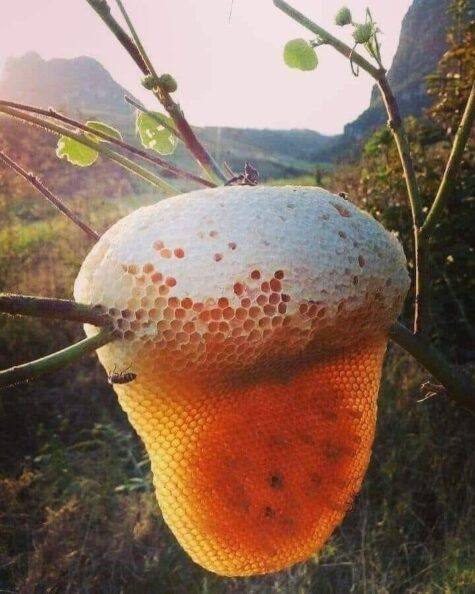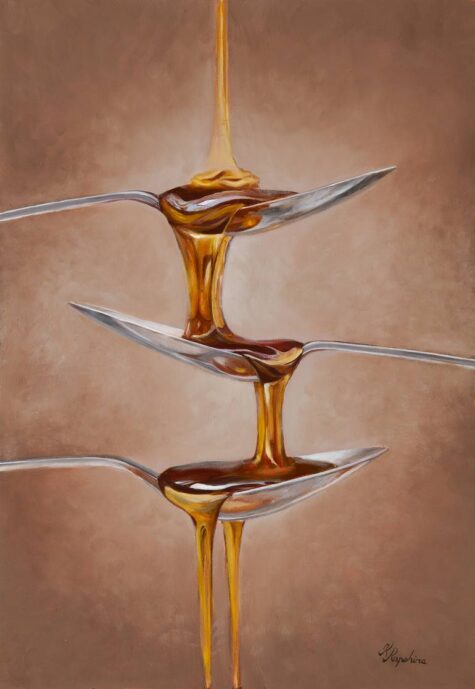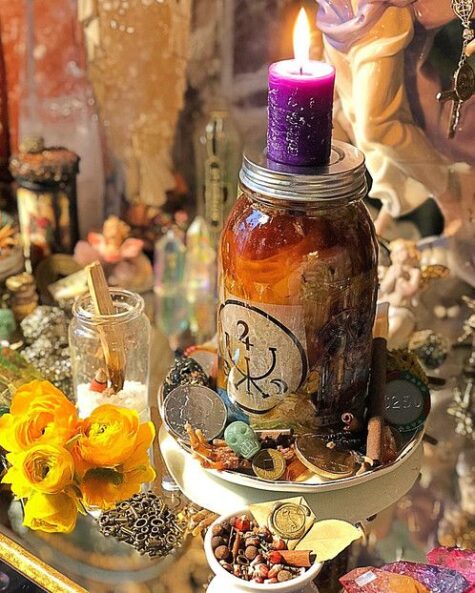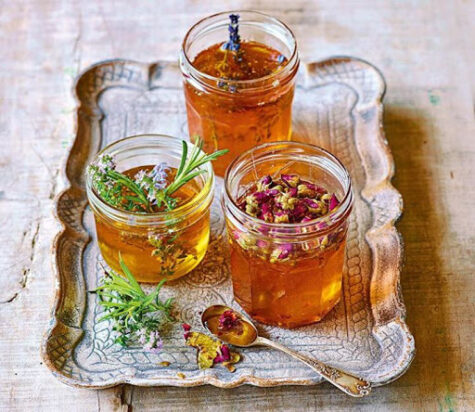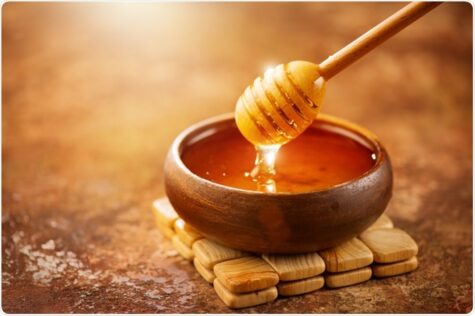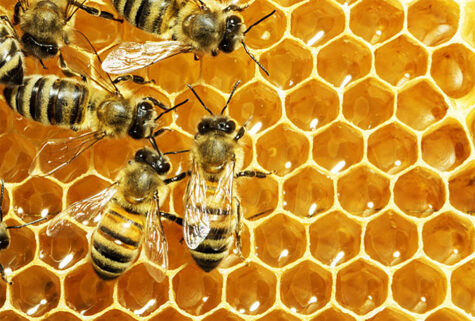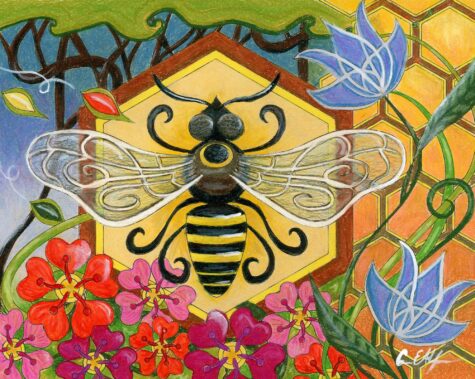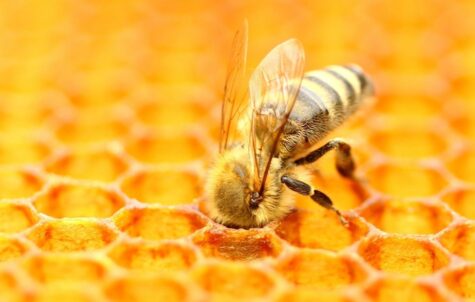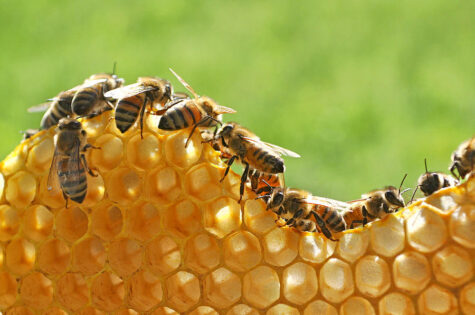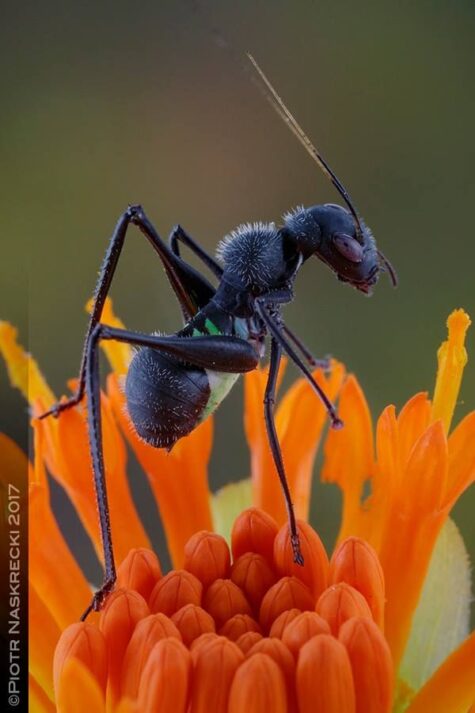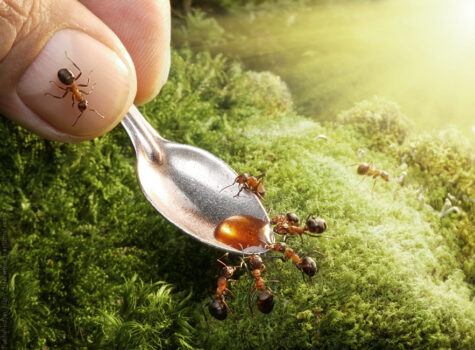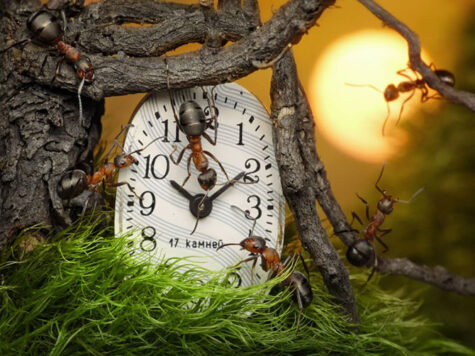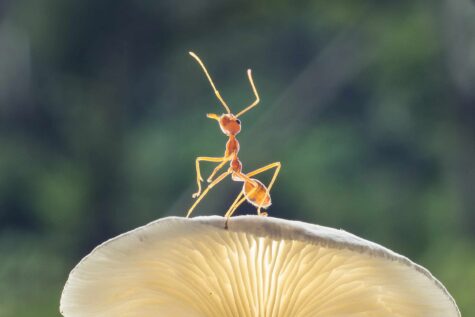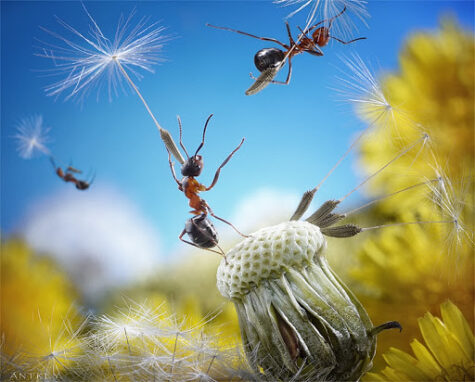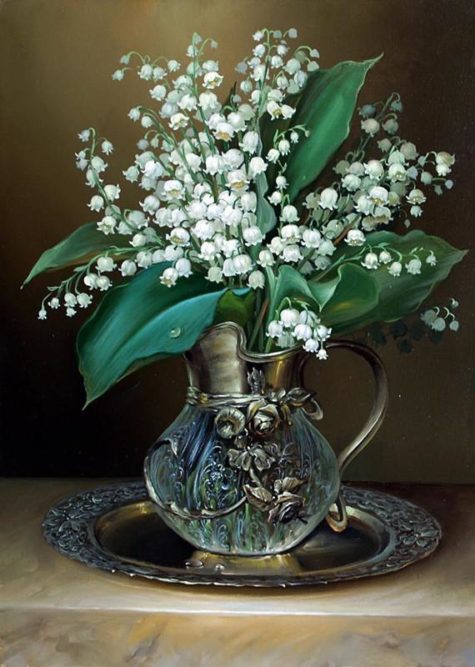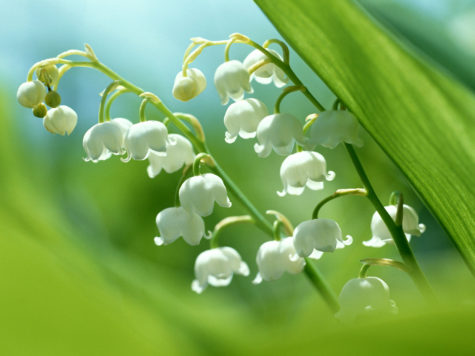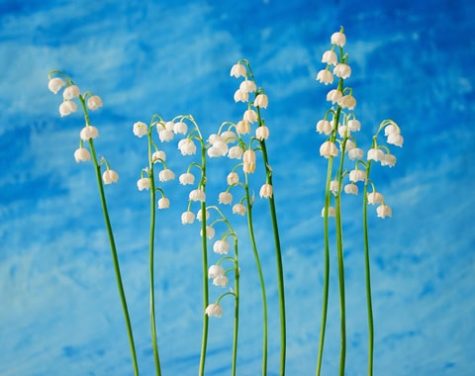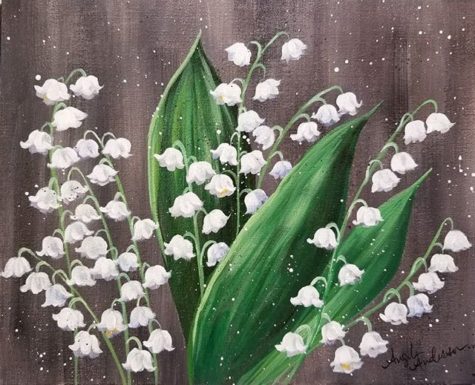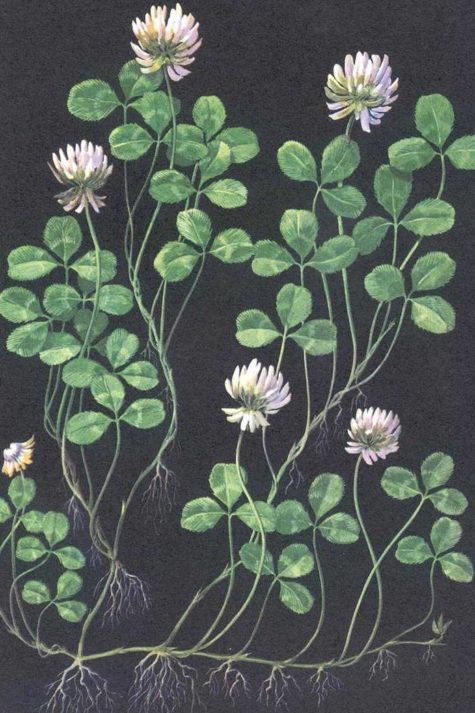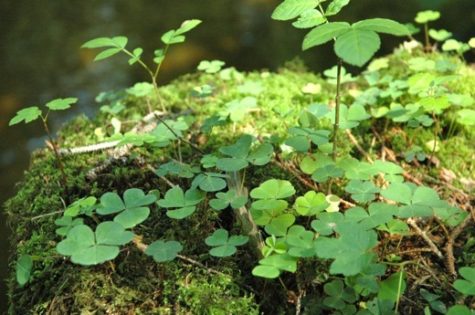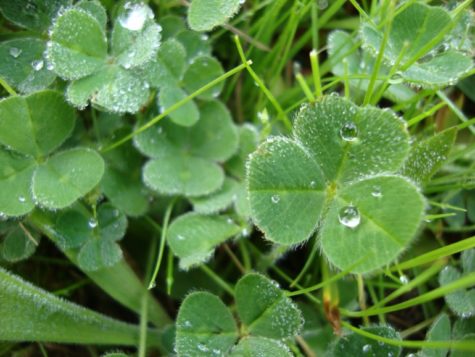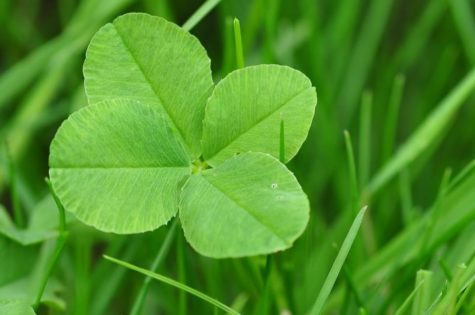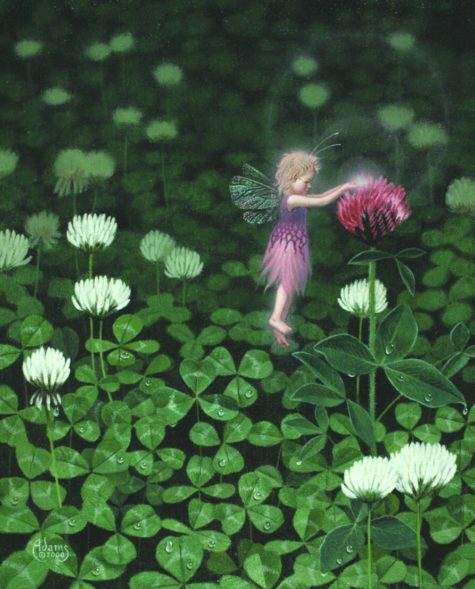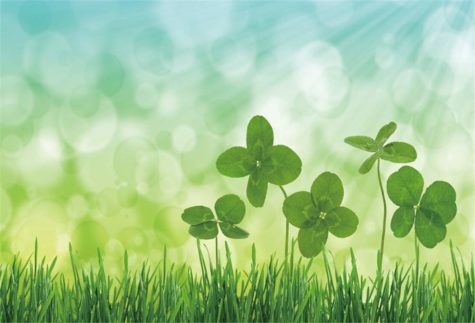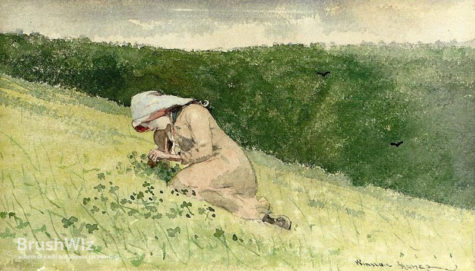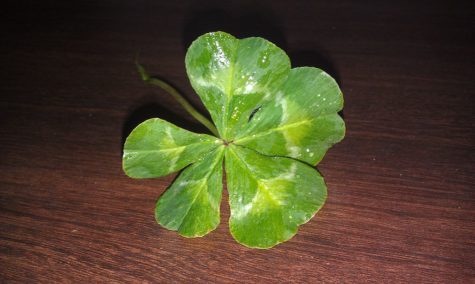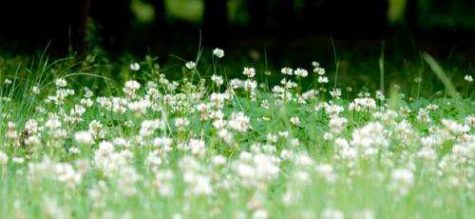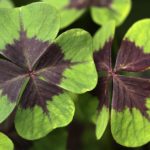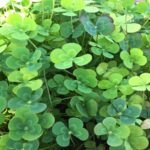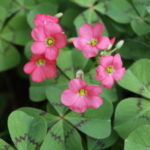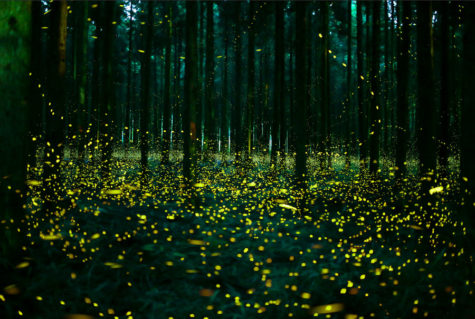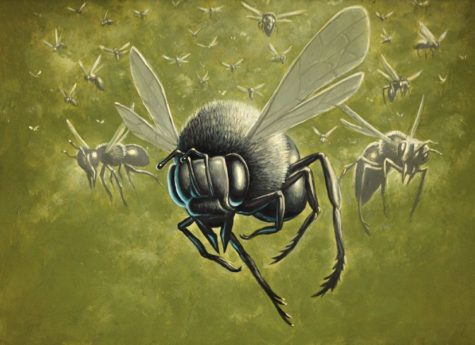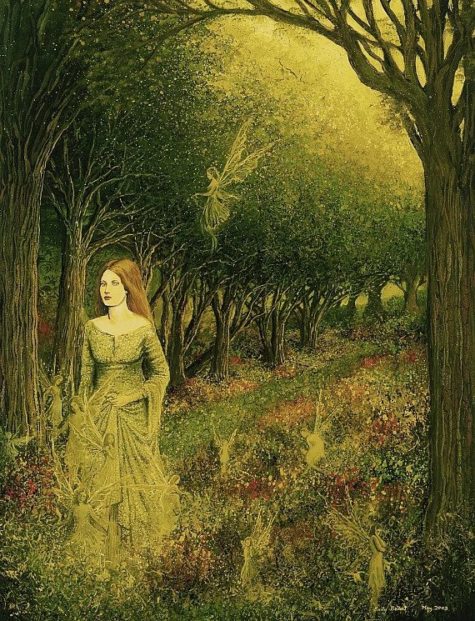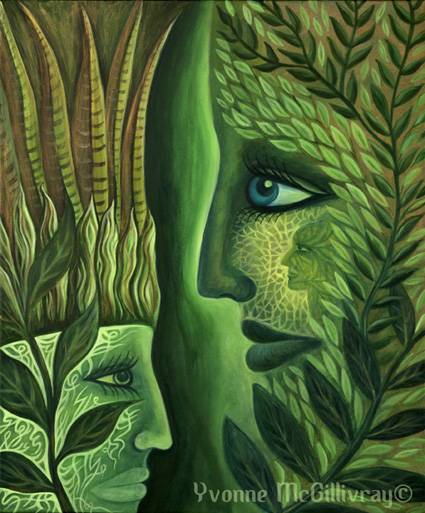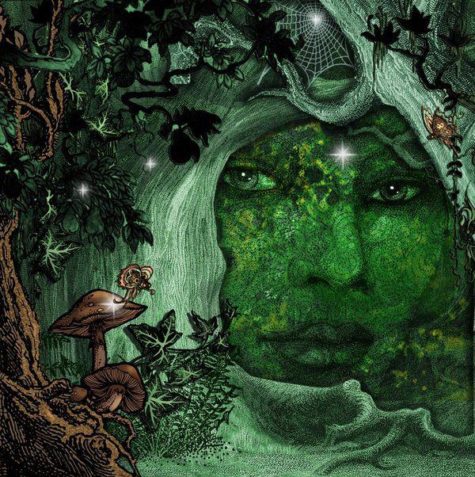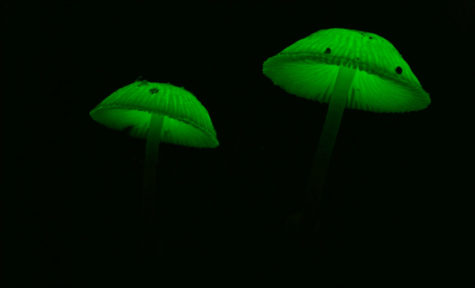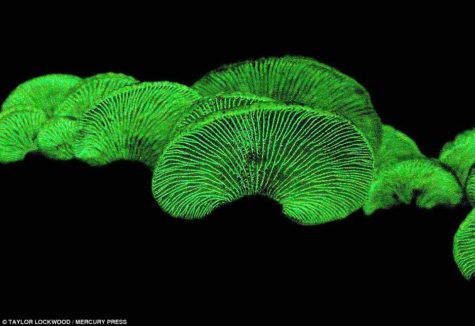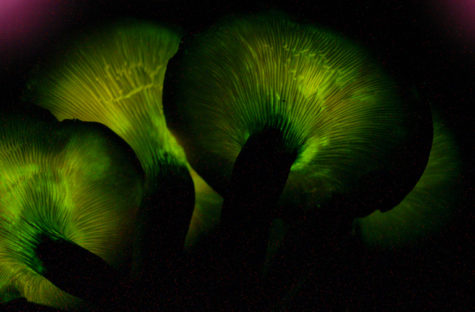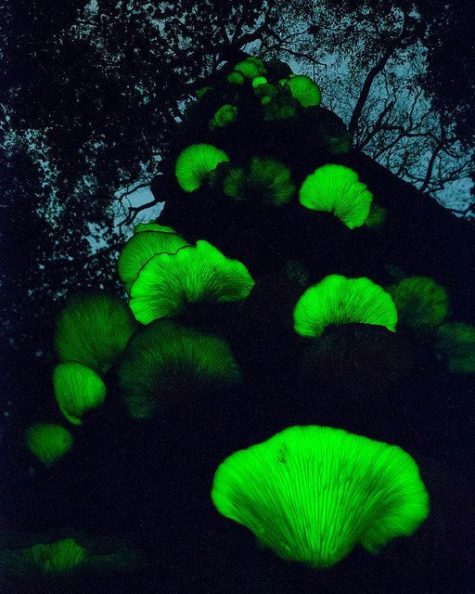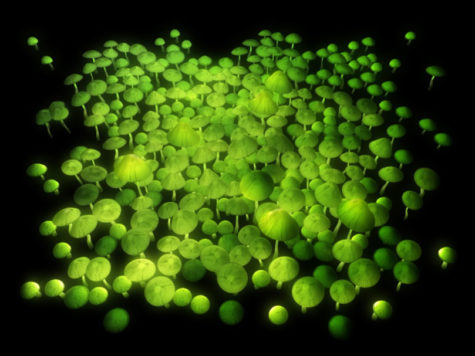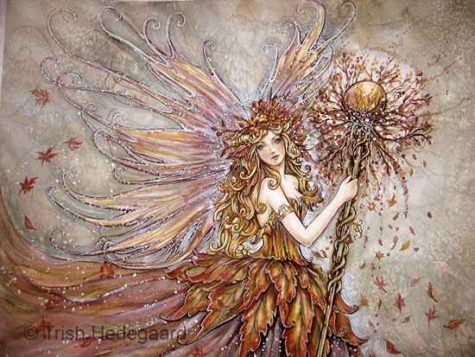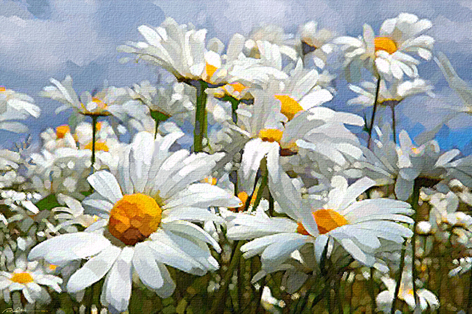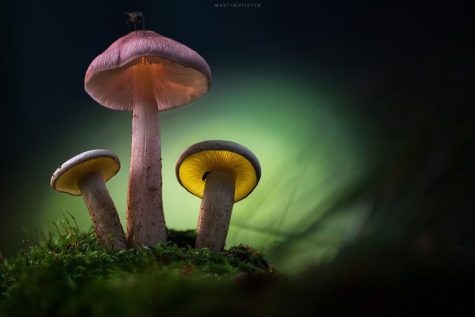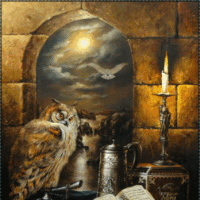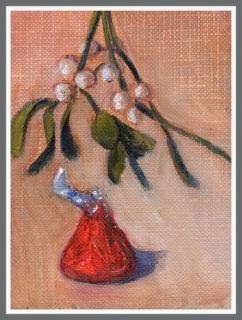Fairies
- Rulers: Oshun, Ra, Vishnu, Krishna, Aphrodite
- Element: Water, Earth
- Gender: Feminine
- Number: Six
- Sacred Geometry: Hexagon
- Type: Food
- Magickal Form: Any type
- Qualities: Sweetening, Binding, Happiness, Healing, Love, Prosperity, Passion, Spirituality, Faerie
Honey – the glorious nectar of the bees is one of the oldest foods known to man…and woman. Honey’s history is extensive. A 8,000 year-old cave painting in Valencia, Spain depicts humans hunting for honey. Honeybees were sacred to numerous ancient civilizations including ancient Greece and Egypt. Our ancient ancestors knew that honey isn’t JUST good to eat, it also has multiple medicinal benefits.
The oldest honey ever found comes from an Egyptian pyramid – it’s three thousand years old and still perfectly edible! Microbes don’t grow on honey, moreover preservation lasts for thousands of years!
The Egyptians held the honeybee in high regard and used honey in their mummification process. Therefore honey was a sacred substance and sacred to any gods and goddesses of the underworld and the dead: i.e. Anubis and Osiris. In Ancient Greece, the high priestess of Aphrodite was “Melissa” which translates to “bee”. She tended to the sacred beehives at Aphrodite’s temple on Mount Eryx.
Honey has a number of magickal proprieties, uses and distinct energies. the energies vary depending on which strain of honey you are working with. but overall I would describe them as positive, cleansing, gentle, soothing and warming. its great for spells, offerings and brews.
Honey can be added to any spell work or any culinary recipe to sweeten someone’s mood or disposition. Honey works well for happiness, love, prosperity and healing, it can also add a bit of zing to your love life too.
- Honey makes an acceptable offering for deities.
- It can be kept on your altar (I keep some on my altar to remind me that amongst the seemingly overwhelming bitterness of everyday life that sweetness can be found).
- Can be used in spells having to do with love, lust or sexuality.
- Purification (works great in bath scrubs).
- Health and healing.
- Community or communication.
- Abundance and prosperity.
- Spirituality.
- Candle magic (for anointing or beeswax candles).
- Honey can be used to represent wisdom, because gathering honey from hives can be difficult and painful if done incorrectly so it became a metaphor for obtaining knowledge through pain.
Honey is used to make mead which is absolutely delicious and wonderful to use in ritual and offerings…half a glass and I am away with the faeries…who actually like a drop of mead or honey as well…
Because of its sticky properties, honey can be used in magick to hold two things together. Some magical traditions use honey to bind a couple that has a shaky relationship. If you want to do a honey binding on a couple – or even on two friends who are struggling with their friendship – you can use poppets with a layer of honey between them, and then wrapped with a cord. Because honey does not solidify, you can always separate the two poppets later with minimal disruption. It’s good for binding spells because it can be undone fairly easily.
Use honey to sweeten a situation: angry co-workers or boss, court cases, family quarrels, divorces, etc. In addition, binding things or people together and keeping things flowing steadily. Healing and cleansing rituals include honey.
Use this sweet and sticky substance to attract good fortune, fertility, and love.
- For wealth, create an altar with coins drizzled with honey.
- For a conception spell, cover a pumpkin with honey and offer to a river.
- For love, bathe in warm water and honey.
- Add a drop of honey to incense blends to sweeten the mood.
- Add a spoon of honey to a bath to cleanse and sweeten your aura.
- Drip small drops of honey onto or around candles for love and prosperity spells.
- Leave on outside altars to attract faeries.
- Use to summon angels and light beings.
- Anoint your third eye with magical honey to dream of your future love.
If you do any kitchen magick, honey can come in very handy. Use it in dishes to bring about sweetness, fertility, or prosperity. You can use honey in rituals as an offering to deity–many goddesses and gods seem to appreciate it. You can also use a blend of milk and honey to asperge a sacred space if you’re holding ritual outdoors. Add some into a bath scrub for a ritual bath prior to working for love or romance, or anoint a candle with it when you’re doing candle magick.
Some ancient cultures used honey in embalming procedures. It’s always appropriate to leave offerings of honey at a gravesite. In addition, the folklore of a number of societies indicates that a blend of honey and milk is an acceptable offering to a deity. Honey makes an excellent offering to the gods, the spirits and the Faerie world.
Poured into the ocean and river, honey is an appropriate offering to sea and river goddesses like Oshun and Yemaya. Keep on the altar as a link to ancient bee priestesses and honeybee spirit guides.
In particular, honey is sacred to Aphrodite, the goddess of love and beauty. This is also a favorite offering for other love goddesses. An assassination attempt was once made on the African love goddess, Oshun. The plot was to poison her with honey. In remembrance of this, always taste the honey first before offering libations to any goddess.
In Hindu texts, honey is described as one of the five sacred elixirs of immortality. The Buddhist faith celebrates Madhu Purnima, which honors the day that Buddha made peace among his disciples – and honey is given as a gift to monks in his honor.
Honey Jars
These jars are also known as “sweetening jars,” and can actually contain almost any kind of pure sweetener, such as brown or white sugar, molasses, or syrup. You can make jars for each person you want to sweeten if you’re working more elaborate spells on them, or keep one jar with lots of names in it for general sweetening.
In some forms of Hoodoo and folk magick, honey is used to sweeten someone’s feelings towards you. In one traditional spell, honey is poured into a jar or saucer on top of a slip of paper containing the person’s name. A candle is placed in the saucer and burned until it goes out on its own. In another variation, the candle itself is dressed with honey.
Herbal Infused Honey
Honey comes in many forms and from many places all over the world. It varies in color, sweetness, and flavor depending on the region and plants. Some people enjoy infusing herbs and flowers directly into the honey itself. Depending on the herb or flower infused, it will alter the honey magic properties and can be further used for those purposes. For example:
- Lemon balm infused honey: soothes nerves and anxiety and aids in falling asleep; also invokes joy.
- Lavender honey: has honey magic properties of relaxation, love, beauty and purification.
- Rosemary honey: purification, money, love, healing, mental clarity.
- Mint honey: money, prosperity, cleansing, and love properties; plus mint aids digestion.
- Thyme honey: the PERFECT offering for attracting the faery folk to your garden! Thyme is a favorite of fairies as well as honey.
- Rose honey: love, healing, protection, long life.
Medicinal Properties
During the late summer and early fall, honey is a staple crop in many parts of the world. This deliciously sweet and sticky gift from the bee population is considered a health food – it will protect you against allergies if you eat just a teaspoon of locally sourced honey each day – and also has a number of magickal properties.
Honey is incredibly beneficial medicinally but also brings a good dollop of happiness with it. Honey is great for cold and flu treatment. Raw and organic honey is preferable as it is an antibacterial and is high in antioxidants. It can be used in an ointment for treating wounds, burns and cold sores. Honey is also an excellent hangover remedy.
Honey will help in muscle building; a teaspoon of raw organic honey after a workout can induce an insulin spike, allowing your muscles to get the most out of the workout. It can be used as a weight loss aid. Honey can cause changes to the metabolism that will help curb sugar cravings.
The healing power of honey has been known throughout the ages. Honey was used as a traditional Ayurvedic medicine, where it was thought to be effective at treating imbalances in the body. In pre-Ancient Egyptian times, it was used to treat wounds. The Prophet Mohammad glorified the healing powers of honey, and the Quran praised its healing ability.
Sacred Geometry of the Honeycomb
At the heart of our seasonal reverence, there is always light. In the dim light of midwinter we gather around a fire. My children tell me their own creation story of winter’s sleepy sun. It is her time to rest and the small brave fire remains beside us, a comfort in our sun’s absence…
We know winter happens because of the tilt of the earth, and we seek the fire because it warms us. Our winter fires provide one small spark of the sun’s fire. And the light of the sun not only gives us warmth, but color. We are cool blue in winter like the twilight that edges our days and we dream of the season that will fill our world with yellow particles of light like the pollen of the sun.
Many of us hold a glowing beeswax candle on special days during a festival or to create a ritual space. In his bee lecture, Rudolph Steiner compares beeswax to the material of our human body, the worker bees of the hive to the blood coursing through us, and the hexagonal shapes of the honeycomb to our cells. Structures of living organisms are mirrored throughout the natural world and beeswax reminds us of our relationship to the earth. The sweet smell of it when we light a candle is a hint of the warm comfort a bee might find in her small sacred capsule.
Each cell of the honeycomb is a hexagon. It is the perfect shape, the one that holds together in strength and efficiency. There is no waste in a system of cells that fit together at perfect angles, a necessary consideration when a honeybee must consume about eight ounces of honey to create one ounce of wax. The worker bees create their city of hexagons in tandem, each bee following her inherent plan of geometric repetition.
Each cell of the honeycomb may hold the golden honey, converted nectar from meadow flowers; or the precious life that will someday gather more honey, the bee’s larva. So the worker bee creates these small spaces as vessels of life, whether she is aware of this significant purpose or not. We can watch the honey bee create these small sanctuaries, her working body warming the cell as she forms it. This is her part in the circle of life and she puts her heart into her work.
If you wish to draw the honey bee’s symmetrical hexagon shape, you may start with the hexagram, the star that is made by overlapping two equilateral triangles. Connect the points of that perfect star to make the most precise hexagon. The star inside the hexagon holds the poetry of the honey bee’s sacred forms and their relationship to the spiritual body of our human world.
The hexagram, the six-pointed star, is the shape associated with Anahata, the heart chakra. It is the Star of David, it is associated with the Kabbalistic tree of life, and it is one symbol associated with the Christian Son of God. The hexagram is significant in Tibetan Buddhism, in astrology, in occult magic and Wicca practices. Here, once again, is nature’s pattern of repetition through time and space and meaning.
The honey bee sings while she works and we hear her spirit song. Her hum is spun into the fiber of summer so that we associate this vibrational sound with brilliant rays of sunlight that make us stop and close our eyes and feel the sun on our faces. It is no wonder the wildflowers turn their faces toward the sun and are graced by the light healing touch of the gentle honey bee.
The Bee Connection
Bees are incredibly magickal and are often said to be messengers from the Gods and the spirit world.
Tell it to the bees…they are great listeners…when a beekeeper died folklore says that the survivors must tell the bees of their keeper’s death and persuade them to stay rather than follow their keeper to the otherworld.
Anything important should be told to the bees such as marriages, births and other important events but make sure you whisper politely.
Bees are also considered to be an image of the human soul, perhaps due to their natural ability to find their way home from great distances.
Save the Bees!
Humans have relied on the honeybees’ magical work for thousands of years. Not just for honey and its unique magick, but also because honeybees are one of our biggest pollinators! They help us make food by pollinating many of our fruits and vegetables. But sadly, the honeybee populations are dwindling worldwide.
Particularly in the U.S. where there’s a link between pesticides and honeybee disease/death. If all of the honeybees die out, we lose a large portion of our food source. So how do we support the honeybee population and health? Here’s some ways you can help:
- DON’T use pesticides in your lawn or garden and encourage your friends, family and neighbors to do the same
- Plant NATIVE flowers, trees, and shrubs. Native flowers and plants aid your local honeybee and other pollinator populations by providing a natural nectar source
- Put a bee bath in your garden for the bees to bathe and drink
- Support your local organic beekeepers, farmers and gardeners in their efforts to save the honeybees
- Instead of having a honeybee hive destroyed – have someone come out and remove it and re-locate it
- Stop cutting down trees that don’t need to be cut down! Bees and other pollinators and wild life need trees too!
Learn more about how to save the bees here! Help The Bees
Important Note
There is a MAJOR difference between natural raw unpasteurized honey, and processed filtered honey. Most commercial honey has no traces of pollen and lacks beneficial vitamins and enzymes among a host of other natural constituents which are removed due to pasteurization and processing.
Most golden honey you see at your local grocery is dead and far from the health promoting powerhouse of its raw unpasteurized counterpart. Processed honey is not honey at all, and if you desire any kind of health benefits, you must stick to the real stuff.
Sources:
- Magickal Ingredients
- Honey in magick and Folklore
- Vaya’s Witchcraft and Spiritual
- A Kitchen Witch’s World of Magical Food
- Honey Coyote
- Otherworldly Oracle
- Wanderlust
- Shelley Giordano
- Keynote: Industriousness, Order and Discipline
- Symbolism: Patience, Stamina, Planning, Energy, Communal Living, Storing for the Future, Group Minded, Perseverance, Step by Step, Teamwork, Industrial Creativity, Dynamism.
- Number: 12
Despite its apparent insignificance, the ant was one of the teachers of the wisest of kings, Solomon, and is a sacred creature in Islam.
Given the habits of the ant, it is no surprise that this tiny creature is primarily a symbol of industry. Because it often carries seeds and grains, in Ancient Greece the ant was sacred to the Goddess of the Harvest, Demeter. However, the industry of the ant seems to be concerned with one thing, the storage of material goods. Therefore, despite all its hard work, the ant is a symbol of materialism to Buddhists.
The teamwork of ants is notorious and many tiny ants together can shift loads far heavier than they are. The ant is a good example of the “sum of the parts being greater than the whole,” and for Hindus this represents the idea of the Godhead.
Ant Magick
Scouting ants seem to walk around at random, so some hoodoo ant-tricks are intended to make an enemy wander in body (never settling in one place for long) or in mind (unable to concentrate, make decisions, or carry out plans. For wandering spells, any small ant will do.
For jinxing spells red ants are the best, because their nest-mounds are easily disturbed, they are quickly angered, and their bite is inflammatory and painful.
To Force an Enemy to Wander: Capture the left foot track of your enemy by scraping it up from heel to toe. Mix it with sugar and lard and put it in an ants nest, and the person will have to wander around just like the ants.
To Run a Woman Crazy: If you get a woman’s bloody menstrual pad or tampon, and you put it in a red ant next, the ants will eat it, and she will go insane with female trouble and a wandering mind.
To Make A Person Return: If someone has left town and you want him or her back, go out at sunrise, stand in front of a red ant nest and call the person’s name three times, each time asking the ants to make the person wander through the world until he or she is forced to return to you.
For Training Dogs: If you feed a guard dog nine red ants in a piece of cornbread, he will attack all intruders. If a hunting dog is fed three black horse ants in cornbread each day for three days, he will range better when hunting because he will “wander” as he hunts.
Ant eggs were formerly used in magickal compounds intended to destroy love. I have not, however, found any actual recipes for those compounds. Anthill dirt is also magickal, you can read about it here: Anthill Magick.
The Medicinal Ant
In Topsel’s History of Four-Footed Beasts and Serpents (1607), the following cures for warts and swellings is given:
Reckon how many warts you have, and take so many ants, and bind them up in a thin cloth with a snail, and bring all to ashes, and mingle the with vinegar.
Take off the head of a small ant, and bruise the body between your fingers, and anoint with it any imposthumated tumor, and it will presently sink down.
Ant Mythology and Lore
In Cornwall, England, locally known as Meryons or Muryans, were once thought to be fairies in the last stages of their earthly existence. Legend said that these elfin creatures went through many gradual transformations, always becoming smaller and smaller, until finally, after living for some time as Meryons, they disappeared altogether from this world.
According to one tradition, the Cornish fairies were once Druids who refused to accept Christianity and so were condemned to lose their human status. Another tale says unbaptized children took this form after their death, being safe from Hell because of their innocence, but unable to enter Heaven because they were not christened. In both versions of the legend, they eventually became Muryans, and hence it was considered very unlucky to destroy an ants’ nest.
Old English folks associated the ants with the Underworld and death. Since the ants build complicated structures under the Earth’s surface, it is expected for their spiritual meaning to be linked to death.
Ant was also part of Greek mythology. The Greek word for ant is myrmekes, and it was believed that people Thessaly were descendants of ants. Another Greek myth speaks of Myrmex, an attic girl who was very dear to Athena, the goddess of wisdom. When the goddess invented the plough, Myrmex claimed she made the discovery. For this audacity, the goddess transformed the girl into an ant.
Because ants appear to be highly industrious and motivated, they have long been a symbol of work and industry. Partly this is due to the Greek tales of the ant, such as is found in Aesop’s Fables. Their wisdom and intellect in their endeavors is often acclaimed.
This diligent insect is an essential figure in Native American folklore and mythology. The Hopi people believe that the first world ended in fire. During this calamity, the Ant People saved the Hopi by taking them to underground caves.
People from northern California believed that ants could predict earthquakes, and it was forbidden to disturb their anthills. The Cherokee had an Ant Dance among their tribal traditions. According to a Salish legend, the Ant woman won the daytime from the Creator after defeating the Bear in a dance contest.
In South America these insects were often depicted as warriors due to the South American fire ants’ painful sting. Some of the initiation rituals included young people exposing themselves to ant bites.
In the Philippines, locals still believe in a myth which states that anthills represent entrances to the mystical kingdoms where ancient pagan gods dwell. The Filipinos do not touch these earth mounds, not even look at them.
Kuba people from Central Africa have a beautiful legend about the creation of the world and the white ants’ appearance. It is believed that Nyonye Ngana, son of the creator god Mbombo, created the white ants but died shortly after. The ants dug after black soil to bury him and thus transformed the Earth’s surface.
The Kabyl and Berber tribes from North Africa tell a story about the ant who taught the first humans how to use grains and plants. The first man and woman lived underground, and the ant showed them how to grow wheat and make bread.
The Maasai people appreciate ants due to their courage and healing powers. The powerful jaws of the driver ants are being used as stitches by the Maasai moran warriors.
Ant Dreams
According to many psychologists, dreaming of ants is related to the work ethic. Because ants are so industrious, it is considered bad luck to dream of them. This is a sign that you are overly concerned with prosperity and material possessions.
If you dream of ants on your clothing, or coming into your home, you will have petty annoyances. To watch ants is to indulge in activity; usually a lot of small jobs. An anthill in a dream is a sign of avoidance of work. Dreaming about ants crawling all over your body means that somebody is annoying you.
Dreams about ants flying, or an ant bite represent your need to free yourself from the daily routine. A dream about fire ants means that you have some regrets related to past actions or experiences.
When speaking of the dream interpretation, ants’ color is also an essential factor to take into consideration:
- Dreaming of red ants means that you might experience some difficulties or anger in your work relationships.
- The red ant dream meaning reflects some minor insecurities that make you feel uncomfortable.
- White ants in dreams symbolize hidden issues are happening right under your nose.
- Black ant’s dream meaning is related to minor displeasures that you deny or ignore.
Leaving aside the different interpretations, dreams about ants might be a sign that your spirit animal responded to your call. Perhaps you feel unimportant and neglected; therefore, the ant power animal comes to guide you through the obstacles.
Ant Superstitions
It was said at one time that if a piece of tin was put into an ant nest when the moon was new, it would turn into silver, provided that it was inserted at a certain fortunate moment which varied in different parts of the country.
- It is an indication of prosperity if ants build a nest close to your front door.
- It is considered a sign of bad weather when ants are noticeably busier than usual.
- An ant bite represents arguments and quarrels.
Black ants are considered quite auspicious. So if you see black ants roaming around your house then it means that soon there will be a sharp rise in your wealth. One the other hand, red ants are considered to bring bad luck. Red ants in the house means loss of wealth.
Although black ants are considered auspicious and indicate happiness, peace, prosperity, they should not be present in a huge numbers. If they are breeding in your house then take appropriate steps to show them the way out.
- Black ants coming out from a rice box means you will soon get money from somewhere.
- If ants are found in places where you store your gold jewelry, it indicates that you will get gold items.
Red ants are associated with the devil and believed to bring bad omen so if you see them in your house, so immediately remove them. However, if red ants exit from your house with their eggs in their mouth then it is a good sign.
If one found the red ant on their path then crossed or even jumped over them then that was a sign of bad luck and possible danger that day.
If ants are coming from the North direction then it indicates happiness and if they are coming from South then it indicates profits. Ants marching from East means you might hear some negative news and if they are present in the West direction then there are high chances that soon you will go abroad.
In most traditional African traditions, there were many beliefs that were linked to the ant. This was in relation to sowing and harvesting. It was thought that the ant can help predict good and bad weather, this was associated with direction in which the ants were moving. For example, if ants moved from east to west in a group then in was an indication that the harvest was near. On the other hand if they moved from west to east then in was an indication that the rains were approaching and thus people were supposed to prepare their fields for sowing.
- To see an ant cross ones path is generally a positive omen.
- To see ants running away from you denotes that someone will be speaking about you to others.
- If an ant fights with another then this suggests that an enemy will be near you within the next week.
- To see a number of ants in a row on the floor (a trail of ants) and this trail goes under a door or chair, this is a sign that you have not told the truth to someone during a conversation.
- If the ant has been stepped on then this is a sign that one will die within a year.
Some Interesting Ant Facts
There are many types of ants, some of which are solitary, but most of which are part of a larger community. Though drudgery is often associated with them, this is far from true. When by themselves, they display simple and uncomplicated behavior patterns. Within the community, there is a repertory of activities and behaviors.
Ants live everywhere on Earth and thrive in most ecosystems. Their ability to modify habitats, exploit resources, and defend themselves made them successful in different environments.
Fire ants specialize in exploiting disturbed habitat, and they’ve thrived in part because humans have done a lot of disturbing. People tend to hate and fear them but this seems a little unfair, since opportunistic fire ants will devour termites, ticks, weevils, mosquitoes and other major threats plants, property and people.
Ant colonies, known as anthills, are some of the most impressive structures found in nature and are good examples of structured organizations. The worker ants are skilled architects. They build complex homes, galleries, and even vaulted ceilings.
The familiar dirt mound around which smart humans cut a wide swath is actually a solarium that collects heat to warm its residents. The tunnels below it hold anywhere from a few dozen to several hundred thousand of the highly territorial critters. A mature colony can encompass approximately 300 feet of underground foraging tunnels – about 20,000 ant body-lengths. On a human scale, that’s the staggering equivalent of 20 miles or more.
Ants are social. Much of their work centers on community activity. The primary activities are gathering, hunting and growing. Yes, some ants do farm, growing a kind of fungus. Ants also participate in food exchanges within the community, and they will often make slaves of other ants to perform labors.
The queen ant has wings and the ability of flight until fertilized. Once she is fertilized, she pulls off her own wings, sacrificing her own flight for the birth of newborns. The queen usually dies after twelve years.
Sources
- Parts Used: Fresh flowers
- Planet: Mercury
- Element: Air
- Magickal Influences: Peace, Conscious Mind, Memory, Attracts Fairies
Convallaria magalis, the botanical name for Lily of the Valley means “that which belongs to May,” making lily of the valley the recognized flower of the month of May, and thus, May birthdays. It is also the official flower of the zodiac sign Gemini.
This plant is also known as Little Maybells, May Bells, Mary’s Tears, Our Lady’s Tears, Jacob’s Ladder, Ladder to Heaven, Jacob’s Tear, May Lily, Convail Lily, Lily Constancy, Muguet, Male Lily, Convallaria, and Fairy Cups.
The well-known and dangerous effects of lily of the valley apply to its internal use, but not to its fragrance. Don’t eat, drink, add to your bath water, or rub into your skin.
Lily of the valley is a fragrant flowering plant used in religious ceremonies, world celebrations, perfumes and in gardens. Also known as the May lily, the name means “return to happiness” and most often symbolizes chastity, purity, happiness, luck and humility. Its meaning and symbolism are represented in Christian lore and folklore, on May Day, weddings and birthdays, and in various celebrations throughout the world.
This tiny plant produces sprays of white, bell-shaped flowers that emit what Culpeper calls a “pleasant, grateful scent.” The aroma instills peace and strengthens the conscious mind. With visualization, the scent will heighten your ability to recall old information and strengthen your powers of memory.
Although the cut flowers are occasionally available in florist shops in springtime, no true lily of the valley essential is available.
This European native plant was first cultivated in 1420 and is beloved by the Fae and humans alike. It is sometimes called Fairy Cups, because the flowers look like cups the fairies have hung up while dancing. The flowers are said to ring when fairies sing and to form ladders fairies use to reach reeds from which they weave their cradles. Obviously, this is a good plant for attracting the Folk to your magickal garden.
According to folklore, this plant blooms on the grave of someone who was executed for a crime they did not commit. It is thought that planting them in the garden will protect the home from ghosts and evil spirits. Although some people consider it bad luck to bring the flowers into the house, in France, people still trade gifts of this plant on May Day in order to have good luck through the year.
The scent of this flower is said to attract nightingales and to give people the power to see a better world.
In the language of flowers, Lily of the Valley means return of happiness, purity of heart, sweetness, tears of the Virgin Mary, you’ve made my life complete, humility, happiness, love’s good fortune. One legend of the lily of the valley is that it sprang from Eve’s tears when she was kicked out of the Garden of Eden.
As a symbol of chastity, purity, modesty and happiness, lily of the valley has been a popular wedding flower since the Middle Ages. According to legend, its strong fragrance lures the nightingale to find his mate. For some brides, the flower is the fifth item carried during a wedding, along with something old, new, borrowed and blue. In Holland, the flower is planted in a newlywed couple’s garden as a symbol of the renewal of love.
Lily of the valley is supposed to protect gardens from evil spirits and is known to have been used as a charm against witches’ spells. It is also considered the flower of fairies, its tiny bells used as cups from which to drink.
Some European countries believe lily of the valley prompts visions of heaven, aiding man to see a brighter future. In Germany and Scandinavia, the flower is a springtime symbol of good luck. In England, when St. Leonard of Sussex fought his grievous great battle with a dragon during the sixth century, as a commemoration to his efforts, the flowers are believed to have sprung from the ground where his blood spilled.
It is also believed that the flower is in honor of Maia, the daughter of the mythological Atlas, the oldest of the Seven Sisters and the goddess of growth, increase, fields, and spring. She and Zeus are the parents of Hermes (Mercury), and so she is the grandmother of magick, which was invented by her son Hermes. The month of May is named for her, and the 1st and 15th of May are her sacred days. Her worship survives as the celebration of the Queen of May in the Catholic church. In the past, only women were allowed to worship Maia. In ancient Rome, May was a time of purification and religious rituals, so it was a very unlucky month to get married (pretty interesting considering that nowadays lilies-of-the-valley are a standard in the bridal bouquet and represent marital longevity).
Lily of the valley is associated with Gemini because of the Mercury (Hermes) connection. Gemini rules divination and summoning, and since Mercury rules magick, this is a good plant to use for ceremonial magick or divination. You could make a great oil for aiding divination by macerating (soaking) the flowers in almond or olive oil. Make a number of macerations in the same oil to get a good buildup of scent. The lily of the valley perfumes commonly available are made from synthetics. Growing the plant is the only way to acquire a natural perfume of the flowers.
On May 1, 1561, King Charles IX received lily of the valley as a gift of luck and continued the tradition every first of May by giving the women of his court this fragrant flower. Today, every year in France, bunches of lily of the valley are sold on streets. In some cities, on May Day, folks wear a sprig in their clothing. The flower is also a symbol used on International Worker’s Day (also known as May Day), or Labor Day as it is known in the United States. The Finnish girl’s name Kielo means lily of the valley. It is also Finland’s national flower.
Considered a Mercury herb, lily of the valley was in the past used for illnesses of the head or brain, such as melancholy, depression, epilepsy, and stroke. Its decoction was mixed with lavender and peppercorns and spread on the forehead and back of the neck to bring someone to their senses. However, later it became much used as a far less poisonous substitution for foxglove and applied to heart disease. Historically, Germans have made a raisin wine with some of the flowers. This demonstrates that although the plant is toxic, the poison is poorly absorbed. The sap can be a skin irritant, however. Leaves of this plant furnish a green dye in spring and yellow in autumn.
The sweet, bee-attracting flowers appear in May; folk belief says plant tomatoes when you see them appear. It makes a great groundcover around shrubs, especially under lilacs (blooms at the same time). This is a good plant for the corners of your house, where nothing else will grow. It produces berries but reproduces mainly through creeping rhizomes.
Information collected from various sources.
- Folk Names: Trefoil, Honeystalks, Three-leafed Grass
- Ruler: Jupiter, Mercury
- Element: Earth, Air, Fire, Water
- Types: Red, White
- Magickal Forms: Three leaf, four leaf, and five leaf
- Basic Powers: Protection, Luck, Fertility, and Abundance
Clover was one of the anti-witch plants which protected human beings and animals from the spells of malevolent witches and the wiles of fairies, and brought good luck to those who kept it in the house, or wore it in their buttonholes or hats. Some varieties of clover have three distinctly heart shaped leaves ~ both elements, the number 3 and the shape, contribute to its benevolent reputation.
The shamrock, the form of clover that is synonymous with all things Irish – was known as the shamrakh in Arabic countries and symbolized the triple aspect of the Goddess. A symbol of luck, leprechauns, and wishes, the shamrock is a powerful talisman to carry.
It could be used in love-divination; and to dream of it was very fortunate for young people, since such a dream foretold a happy and prosperous marriage.
Red clover flowers bring good luck in love and marriage matters and are carried in mojos for satisfying conjugal relations and to ensure a happy marriage. White clover flowers protect from evil and bring an end to “crossed” conditions.
In folk magic Red Clover is used in a ritual bath to attract money and prosperity to the bather and is also used as a floorwash to chase out evil and unwanted ghosts. White Clover is used for breaking curses and is worn as a sachet or put in the four corners or a house or someone’s property to achieve this.
If someone has done well in life, he or she is said to be “living in clover.” This probably originates from the fact that cattle grow best when grazing in fields of clover.
Clover keeps snakes away from your property, if grown there. When placed in the left shoe, and then forgotten, clover keeps evil from you. Worn over the right breast it brings success in all undertakings.
If you have been disappointed in love, wear clover near your heart in a piece of blue silk to help you through.
It also protects against madness, strengthens psychic powers, enables you to detect the presence of spirits, and leads the wearer to gold, money, or treasures.
Clover vs Shamrock
The term shamrock is derived from the Gaelic word seamrog which means “little clover.” It is famous as a symbol of Ireland. St. Patrick believed that the three tiny leaves represent the Holy Trinity, which it is all over the place on St. Patrick’s Day.
There is no specific “shamrock plant.” However, most scientists agree that the term “shamrock” refers to Trifolium Repens or the white clover. Others believe that it is also used when referring to Trifolium Dubium or suckling clover. Both species have leaves that are separated into three leaflets, hence the term “trifolium.”
On the other hand, clover or “trefoil” is a common term that refers to any of the 300 species that belongs to the Trifolium family. Trifolium plants like the red clover, white clover, Swedish clover, strawberry clover, and Alsatian clover are small, green, flower-bearing, and herbaceous. They can be short-lived, perennial, or annual.
A clover is trifoliate, which means the leaves are subdivided into three toothed leaflets, although four-leaf, five-leaf, and six-leaf clovers can be occasionally found due to a natural genetic mutation. It is believed that there is only one four-leaf clover in a hundred thousand three-leaf clovers, which is why it is widely accepted as a symbol of luck.
What, then, is the difference between a shamrock and a clover?
“Clover” is a generic term that refers to trefoils, or any of the 300 species that belong to the Trifolium family. These plants have leaves that are separated into three leaflets, but you may find four-leaf, five-leaf or even six-leaf clovers as a genetic abnormality. “Shamrock,” on the other hand, means “little clover” and is used to refer to the white clover species or the suckling clover species. It is also the symbol of Ireland and St. Patrick’s Day.
In conclusion, shamrocks are clovers, but not all clovers are shamrocks. So, that green leaf you see on St. Patrick’s Day? It’s a shamrock and a clover.
Three Leaf Clover
Some folk traditions assign a different attribute to each leaf of a clover. The three leaf clover represents the Holy Trinity ~ Father, Son, and Holy Spirit. Alternatively, it represents the Maiden, Mother, and Crone.
The three leafed clover is often used in rituals designed to protect or to keep one looking youthful and fair. As a protection carry one on your person.
To keep looking young, gather dew on May Day morning, just before the Sun rises. Put into this water three clover stalks. Let these steep all day out of the Sun’s rays. The next morning, again before the sun rises, rub a little of the water on your face. Do this every morning until the water is used up. Cover the bowl with a cloth to keep the water clean and store in a place where it will remain untouched until the following morning.
Early Christian proselytizers, such as St. Patrick, used both the shamrock and the clover to demonstrate the three-in-one notion of the trinity ( father, son, and holy spirit). It is also said that snakes will not venture where clover grows, which ties into the idea of St Patrick and his reputation for driving the snakes out of Ireland.
That said, the Irish had imbued the shamrock with meaning before St. Patrick came along. Three-leaf clovers featured prominently in ancient Celtic rituals and folklore (triads and the number three were considered spiritually significant back then, too).
With its three leaves, Clover is a very shamanic plant allowing one to see into and interact with the Otherworld. It is a good talisman of protection and power for traveling out of body and walking between worlds. Never underestimate the magical power of this simple and harmless weed. It also makes a good offering to Mercurial deities and can be burned with incense, added to ritual smoking blend, made into alcoholic brews, or left with a food offering.
Four Leaf Clover
Although all clover has the same magickal properties, it is the rare four leafed kind that is especially powerful. Such a plant, when found, enabled the finder to see fairies, detect witches, and recognize evil spirits. Anyone wearing a four-branched leaf was safe from malicious enchantments and one hidden in the dairy, or barn prevented witches from harming the milk supply or the butter.
If a girl wore a four leaf clover in her right shoe, the first unmarried man she met on her first journey with it would be her future husband, or if not he, then another man of the same name. Another method is to pin the four leaf clover above the front door of her home. Again, the first unmarried man who walks through her door will become her husband.
There is a story in the Denham Tracts of a Northumberland girl who, when returning from milking, saw fairies dancing in the field. No one else could see them, though she pointed them out. She was not normally second-sighted, and it was afterwards discovered that the source of her vision lay in the circular pad she wore on her head to support the milk pail. Among the grasses with which it was stuffed was a four leaf clover.
Four leafed clovers are genetic mutations of the three leafed varieties, and well-known European – American charms, bringing in (and representing) health, wealth, love and luck, and protecting from witchcraft. An old rhyme is as follows:
One leaf for fame,
One leaf for wealth,
And one for a faithful lover,
And one leaf to bring you glorious health,
Are all in the four leaf clover.
The luckiest four leaf clover is one you find when you are not looking for one. The four leaf clover carries all the symbolism of the number 4.
Some people press four leafed clovers in a book, such as the Bible, and keep them in the house. Others carry a dried and flattened four leafed clover in their wallet, to draw money, even going so far as to laminate them to card-stock to preserve them. Jewelers make effigies of them, working these into key chain fobs, brooches, pendants, and rings.
An old legend says that when Adam and Eve were expelled from the Garden of Eden, Eve took a four leaf clover with her to remind her of the happiness she had enjoyed there. Consequently finding a four leaf clover became a sign of good luck and happiness. Anyone lucky enough to be in possession of a four leaf clover has a piece of the blessed Paradise.
In the seventeenth century, four leaf clovers were sometimes strewn in the path of a bride to provide her with extra protection from evil spirits on her special day.
Four leaf clovers are carried to prevent madness. It is also a popular amulet to avoid military service. Gather the four leaf clovers in the morning, then walk to the nearest hill. As the Sun rises throw one clover to the North, and one to each of the other directions, calling upon the powers of the Elements to protect you, to keep you from getting drafted or whatever your wish is. Then, after finishing the ritual, pluck one more four leaf clover (remember, leave something in payment to the earth for the plant taken) and keep it as a magickal link with the elements.
They are also a frequent image on good luck tokens and they appear on greeting cards and postcards conveying good wishes to the recipient. Some say that four-leaf clovers grant the power to see fairies. In other traditions it is said that they are related to St. Patrick’s use of the shamrock to explain Christianity to the Irish, the cross of Jesus being made up of 4 parts.
The earliest mention of “Fower-leafed or purple grasse” is from 1640 and simply says that it was kept in gardens because it was “good for the purples in children or others.” John Melton, an English writer wrote the following in 1620 about the clover:
“That if any man walking in the fields, find any foure-leaved grasse, he shall in a small while after find some good thing.”
A description from 1869 says that four-leaf clovers were “gathered at night-time during the full moon by sorceresses, who mixed it with vervain and other ingredients, while young girls in search of a token of perfect happiness made quest of the plant by day.” The first reference to luck might be from an 11-year-old girl, who wrote in an 1877 letter to St. Nicholas Magazine, “Did the fairies ever whisper in your ear, that a four-leaf clover brought good luck to the finder?”
Five Leaf Clovers
Sometimes a five leafed clover might be spotted by those who have particularly sharp eyesight. Because the number five combines the feminine 2 with the masculine 3 , it symbolizes marriage or engagements.
The five leaf clover also represents the pentagram or five pointed star and multiplies the blessings of the shamrock by five. The first leaf represents hope, the second stands for faith, the third is for love and the fourth leaf brings luck to the finder. A fifth leaf represents money, but there is no meaning as yet for the sixth leaf and above. Some reports claim six to be fame and seven to be longevity, though the notions’ origination is unknown.
Five-leaf clovers are less commonly found naturally than four-leaf clovers; however, they have been successfully cultivated. Some four-leaf clover collectors, particularly in Ireland, regard the five-leaf clover, known as a rose clover, as a particular prize.
In exceptionally rare cases, clovers are able to grow with six leaves and more in nature. The most leaves ever found on a single clover stem (Trifolium repens L.) is 156 and was discovered by Shigeo Obara of Hanamaki City, Iwate, Japan, on 10 May 2009.
Clover Blossoms For Purification
Here are some ways clover blossom can be used for purification:
- Place two drops clover blossom flower essence in a mister of rose water and mist an interior space to purify the vibrations. You can also mist your body and aura for the same purpose.
- Drink two to three cups white clover blossom tea per day to support physical detoxification. Drink two to three cups red clover blossom tea per day to support emotional detoxification (after abuse, a challenging breakup, etc.)
- Take four drops white or red clover blossom essence under the tongue or in water twice per day to support physical and emotional purification.
- Place fresh clover blossoms in bath water, along with one cup sea salt, for a physical/emotional/spiritual purification bath.
- After space clearing, arrange fresh clover blossoms and soy candles together on a plate and place in a central location in a room. Repeat in each room and area of the home, and light the candles to help set the new vibration in place and to further purify and uplift the energy.
Not a Clover
Because four leaf clovers are fairly rare, an unrelated plant called Oxalis (which has similar looking leaves, but entirely different flowers) is sometimes sold as a substitute for them. At Saint Patrick’s Day, many nurseries sell potted Oxalis as “lucky shamrocks.”
There are a number of plants that look like clover and have three or four leaflets. In particular, Oxalis tetraphylla (also known as O. deppei) has spread from cultivation and can be found living wild in various places. It has four leaflets and is actually known as four-leaf clover in some places.
O. tetraphylla is also known as four-leaf sorrel or Iron Cross, and it does look a lot like a four-leafed white clover. The primary difference is that the center of O. tetraphylla is often tinged with purple – and it does not produce the white flowers we normally associate with white clover.
Marsilea mutica, is another plant that is billed as a variegated four leaf clover, and sold as an attractive and versatile addition to your pond. Each leaf appears to be a perfect 4 leaf clover, and is advertised as bringing the luck of the leprechaun to all who view it. Whether luck and leprechauns are truly drawn to it, I do not know.
Sources:
- Encyclopedia of Magickal Ingredients
- Magickal Herbalism
- Hoodoo Herb and Root Magic
- Wikipedia
- Encyclopedia of Superstitions
- Difference.guru
- Sarah Anne Lawless
- Tess Whitehurst
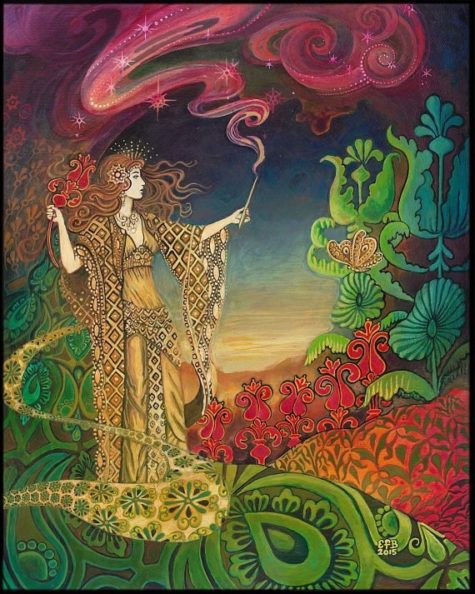
Each plant, animal, rock, and other entity has a spirit (consciousness resonance matrix). These spirits can join together, in a hive-mind, as a spirit of an area. Nature spirits include real biological intelligences, are psychically powerful, and are much less abstract and controllable than the Elementals that many magical people who perform all of their rituals indoors are familiar with. They can be extremely powerful allies.
It is possible to sense nature spirits, to determine if they are receptive to a ritual planned, and to have them actively participate in magical workings if they are.
Some Effects of Working With Nature Spirits:
Spectacular physical manifestations can happen when working with nature spirits in the wild. I have personally seen actual foxfire mark the boundaries of a magic circle at a location that was identified as a receptive power spot and attuned to a planned ritual the day before.
I have seen more than one site attuned for ritual be dry and comfortable, with a round hole in the clouds overhead, on days that were cold and rainy at other nearby locations. Birds have joined in rituals, flying around the circle when energy was being raised; and insects, birds and animals have joined in chants. In addition, the wind often responds to invocations. Generally, these spectacular manifestations happen unexpectedly.
With or without such manifestations, nature spirits often will channel tremendous amounts of power into the magic being performed. It is suggested that you do not consciously try for specific manifestations. Let Nature channel her power into the magic in her own way. If approached with respect, nature may give you many pleasant surprises.
Spectacular physical manifestations are not a necessary sign of success. If you need a spectacular manifestation and nature spirits know this, you will get it. The best success in magic is on the inner planes and more subtle than such manifestations. This success involves beneficial changes in consciousness that last and helpful chains of synchronicity. In addition, working with Nature Spirits can also bring a deep sense of partnership with Nature, and bring new levels of attunement.
To get the best results, perform nature spirit attunement several hours to several days before the main ritual. The purposes of such attunement are to find suitable power spots and to get the help of friendly nature spirits. This timing gives Nature time to gather her children and to prepare to actively participate in the main ritual.
What to NOT do:
If nature spirits are approached with disrespect by attempting to command them rather than listening to them and inviting them to work with you, nature spirits may flee, rebel, or attack. I once attended a ritual by some pseudo-Crowleyites who attempted to perform the “Ritual of the Barbarous Names” at a power spot in a forest and then to extend the circle several hundred yards in all directions.
While the forest in general had loud insect and frog noises, the area at which the ritual took place got quiet immediately when the main ritualist declared that all spirits were subject unto him. The vibes from nature could best be characterized as “Oh yea, Mother…!”
One participant was quickly possessed by an angry spirit and kept repeating “You killed my children, your children will never live in peace.” When the priestess stepped out of the boundaries of the original circle, she was attacked by bees; and bees covered the Book of the Law. Magicians should know better than to attempt to command spirits whose true names they do not know!
Calling Nature Spirits:
To make the most out of working magical ritual in the wild, one should find power spots where nature spirits are receptive to the ritual planned and approach the spirits with respect, as equals. In my experience, the most effective power spots for working with the living intelligences of nature are located in wild areas with diverse, active ecologies.
When entering a wild area to find a site for a ritual, find a place that feels good. Then do the following, either individually or, if in a group, as a guided meditation:
- Relax, while standing upright, and focus on your breathing.
- Breathe deep breaths from the diaphragm. Breathe together if in a group.
- Feel the wind, and let it relax you and awaken your spirit within, as your deep breathing takes you into non-ordinary reality.
- Picture, in your mind’s eye, a light inside you.
- As you breathe, feel the light expand, purify and energize you – as it expands to fill your aura.
- Feel yourself glowing, balanced, purified, and full of power.
- Connect with your inner self (your higher self), and feel your intuitive self operating.
Feel yourself as:
- The wind, full of life and intelligence, communicating with all round.
- The Sunlight, warm, alive, channeling the power to communicate with nature and energizing all around.
- Water, emotional, intuitive, refreshing, and connected with nature.
- The Earth, and note how your physical body is able to wander while remaining part of Mother Earth.
Focus on your spiritual self, and:
- Note the light within and feel it as love,
Expand the light and love beyond the immediate aura of your body to the surrounding area – where you will go to find a power spot and contact nature spirits.
- Telepathically (by thinking while channeling the love and light energy) send out signals to nature spirits to emerge and be aware of your presence.
- Say why you have come, and invite them to join in sharing, mutual celebration, and the work you intend.
- Visualize the light and love energy you are channeling extending out and merging with the light from distant places.
- Feel the power of the Earth flowing up through your body and feet.
- Feel the power from the sky, and channel this power also to further energize the carrier signal of light and love for communicating with nature.
- Visualize the light expanding and merging.
- Continue to send out telepathic signals.
Now go deeper:
- Close your eyes, sit on the Earth, and feel your connection while you channel more light and love.
- Continue modulating the light and love with your thoughts – inviting receptive spirits to join with you and to make themselves known.
- If in a group, someone should start playing a drum at a rate of about one beat per second; and you should listen to the drum and let the drum take you deeper.
Affirm that you are a nature magician, a medicine person, who knows and communicates with nature. Let this part of yourself emerge to full consciousness. Let the drum and the connection to your inner self awaken that part of yourself that naturally communicates with other life forms. Let it awaken your telepathic senses.
- Continue sending telepathic signals to nature.
When you feel ready and an inner urge to begin, open your eyes a crack and look around, while continuing to channel love and light and telepathically calling for a response.
You may see light coming from certain areas that are receptive. You may get other signals, such as a feeling of power or love returning in a certain direction. Perhaps the type of response to this work will be unexpected; follow your intuition in interpreting it.
You may test your connection by communicating (mentally) instructions for signals for yes/no responses (such as light getting brighter for less and darker for no) and then mentally ask questions and observe the responses.
When you have found an areas that seems to be responsive and receptive, begin walking to the area, while beaming love energy. Extend your aura to the area and sense the energy.
Entering A Power Spot:
Before entering a power spot, ask permission to enter. If the response is good, enter; if not, locate another more receptive area.
When entering the power spot, look around. Perhaps the responsive energy will be concentrated around some singularity (a bush, a tree, a specific branch, a moss covered rock, or other entity that stands out). Perhaps the energy will be more general. Use your intuition and feedback from the spirits to guide your actions.
If it feels right, send out a signal that you would like to touch the singularity (or the ground) for better communication. If the response is good, approach beaming love energy, and then touch or hug the singularity (or the ground).
Treat the spirits as you would other Pagans you meet for the first time – be sensitive, open, and listen.
Deepening Communication With Nature Spirits:
Now that you have made contact with spirits that seem receptive, deepen the communication:
- Breathe deep breaths from the diaphragm, and with each breath, feel more refreshed.
- Now imagine that your spine is the trunk of a tree; and, from its base, roots extend deep into the Earth. Deep into the rich moist Earth.
- With every breath, feel the roots extending deeper,
- Feel the energy deep within the Earth and within the waters of the Earth.
- Feel your roots absorbing nourishment from the Earth and from its waters.
- Feel the moist, warm energy rising.
- Feel it bursting up from the Earth and rising up your spine, like sap rises in a tree.
- Feel the energy rise to your crown chakra (at the top of your head).
- Now imagine that you have branches, branches that sweep up and then bend down towards the Earth, like the limbs of a willow.
- Feel the branches extending and interweaving with your surroundings.
- Feel the warm, moist energy of the Earth flowing through your branches.
- As it flows, feel yourself being purified, centered, and connected to the Earth.
- Feel the power from the Earth flowing through your branches and then down back to the Earth, like a fountain.
- Note how your branches absorb energy from the air.
- Also, feel them receiving light (fire) from the sky.
- Feel the energy from above penetrating deep through your body into the Earth.
- Feel the warmth of the Earth rising also.
- Feel the energy circulating.
- Notice how your branches intertwine with the branches of energy surrounding you.
- Feel the energy dancing among your branches and the branches around you.
- Notice how your roots also intertwine with underground energy channels.
- Feel the energy dancing between your roots and the surrounding energy patterns.
Notice how you and the life around you are rooted in the same Earth, breathing the same air, receiving the same fire, drinking the same water, sharing the same underlying essence. You are one with the magical grove.
Telepathically mention the time in the past when nature spirits and people communicated regularly and the need to establish such communication now.
Test your connection by asking questions and observing the responses.
Working With Nature Spirits:
Explain to the spirits the purpose of your coming to them and the nature of the ritual you plan.
If the spirits you contacted are receptive, explain to them the details of the ritual and invite them to provide ideas. Listen, you may receive suggestions on how to improve the ritual. Such suggestions may come in the form of hunches, visions, answers to yes/no questions using pre-arranged signals, or in other ways.
Explain what type of space is needed and ask what the best place to perform the ritual is. You may see light or get other psychic signals leading you to other sites, or you may be at one of them.
You may also ask what the best places for other aspects of the planned work are (picnicking, individual vision quests, etc.).
If preparation of the site is needed (removing briars, preparing a fire circle, etc.) ask permission of the spirits before proceeding with such action.
Before you leave the power spot:
- Tell the spirits you have contacted when you plan to return to do the ritual (visualizing the associated lunar and solar aspects can help with this communication).
- Invite them to join in the ritual when you return and to bring their friends.
- Ask if it would be best to return silently, with drums, with chanting, or with some other form of approach.
- You can also ask the spirits to provide guidance for working in balance and to provide a teacher to provide further guidance.
- Thank the spirits,
- Channel love energy,
- Trigger your memory of the experience,
- If it feels right, leave an offering of tobacco, or beer and honey poured on the ground (or other suitable material).
- Leave in peace and love.
Proceed to other sites that were indicated by the spirits, doing similar meditations at each site.
If you need something, like a staff, a Maypole, or a wand, you can also ask where you can find it and follow the guidance you receive (not slavishly, but as you would guidance from another Pagan).
Before leaving the general area in which you found power spots and contacted nature spirits:
- Channel love energy towards the receptive sites you found,
- Thank the spirits of the land,
- Pull back your roots and branches,
- Ground any excess energy into the Earth (placing your hands on the Earth, breathe in any excess energy, and channel the energy down your arms, while visualizing and feeling the energy going into the Earth),
- Leave in peace and love.
Naturally, you should leave the area at least as clean, and preferably cleaner, than you found it.
If you work with techniques of Wicca or Ceremonial Magic, you may find that by casting a circle, calling the Elements, the Goddess, the Gods, and the local nature spirits while you are at receptive sites, you may be able to greatly increase communication.
Through the use of drums and other power raising techniques, it is even possible to energize receptive nature spirits. The results can be very interesting. If with a coven, such circles can be done as part of a group attunement to a power spot you have located.
If you do not get good feelings in response to your explanation of the ritual and are unable to come up with a ritual that gives good responses, do not try to force a good response. You would only be fooling yourself.
- Thank the spirits for their attention.
- Ask them why they are not receptive (if it feels right and they are communicative).
- Trigger your memory.
- Pull back your “roots and branches,” return any excess energy you feel into the Earth.
- If it feels appropriate, leave an offering of tobacco or other appropriate material, out of respect for the spirits.
- Move to a more receptive site.
If it is hard to find a site that is really receptive, you should consider any impressions you got of why the nature spirits weren’t receptive in the area you were in, and re-think your plans for a ritual, as necessary and appropriate.
It may also be appropriate to look for another general area in which to find a suitable power site that is receptive to the work planned.
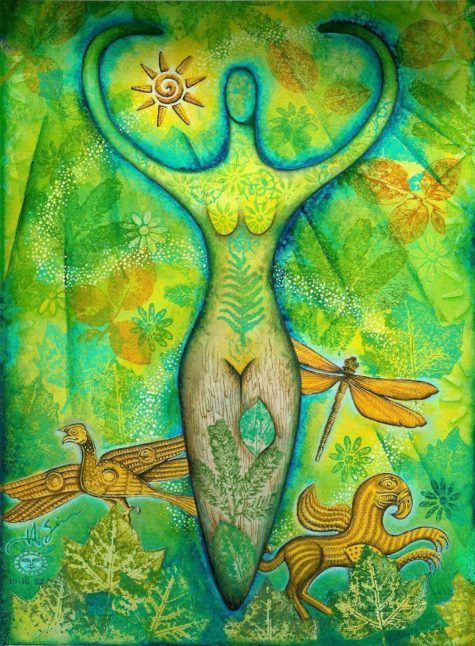
What To Do When Returning:
It can be very powerful to purify and center yourself and to attune to the spirits of the land using the techniques previously described for calling nature spirits immediately upon returning to the site.
Often, individuals may have found small specific power spots to which they have a special attunement, where the spirits are interested in participating; but where the site is too small, has too much vegetation, or is otherwise unsuitable for the main ritual. Individual attunement to the spirits in such areas and inviting them to participate in the main ritual can be worthwhile.
Then approach the main ritual site using the previously arranged technique. You should have the details worked out with the spirits of the land. An exceptionally powerful technique involves doing a procession through or past receptive power spots, inviting nature spirits to join as you pass each power spot, and then moving to the central power spot for the main ritual. If participants are at individual power spots, they can join the procession as it passes nearby.
When consecrating space in the wild, or casting a circle, do not set up the perimeter as a barrier to all outside forces; it should be a beacon to attract friendly nature spirits, a container for holding magical power, and a barrier to spirits who it isn’t right to be with.
One thing that is fun and worthwhile in nature is to bring instruments, such as a rattle, a flute and/or a drum, to tune in to nature’s sounds, and to make music in time to nature’s sounds. You may be able to get some very interesting back and forth exchanges of music going with selected creatures of the wild, and get into an amazing jam session.
After the work is complete, be sure to thank the spirits for their participation. Libations and other offerings may also be left for the spirits during and/or after the ritual.
This article is written by Larry Cornett
- What it is: Bioluminescent Fungi
- Associated with: Foxes, Fox Spirits, Will-o’-the-Wisp, Fairies
- Important: None of the bioluminescent fungi are edible. Do not eat them.
If you ever find yourself walking through a damp, dark woods at night without any flashlight, you might just witness something amazing. If you’re lucky, in the undergrowth concentrated on and around rotting logs, you’ll notice a green or blue glow. It’s foxfire, and it’s beautiful. Often foxfire looks as if the bark of a fallen log or old tree branch is glowing at night. It’s not the wood but rather what’s feeding on it that’s creating the light. With some species, it’s the mushroom cap itself that glows, in other species only the underside of the cap is luminescent.
For centuries this was called fairy fire or will-o-the-wisp and was attributed to something mystical. The oldest recorded foxfire sighting was by Aristotle in 382 BC, he thought it was a cold fire burning on the logs. The actual cause of foxfire was only discovered in 1823 when glowing beams in mine shafts were investigated.
Magickal Uses
Foxfire in the wild is magickal all by itself, and can indicate a message from the underworld, or a warning to be careful where you are going. It not easy to come by, and if you are lucky enough to have a place in the wild where you can see it, be very protective of the area.
If you acquire some foxfire, use it to set a magickal mood, to bring the energy of the fairy realm to a dark moon ritual, or to make contact with Fox Spirits, ghosts, and other creatures of the night.
The compound in the fungi that creates the light is called Luciferin (meaning light bringer), which brings to mind thoughts of Lucifer and the underworld. If you are involved in dark magick, foxfire would definitely be an ingredient that could be added to rituals and spells, particularly for magickal workings designed to lead someone astray.
How can you experience foxfire for yourself?
The best way to see foxfire is in old, moist oak woods where plenty of big dead limbs and old stumps litter the ground. Foxfire can be seen in the spring as the forest floor warms. The light is so dim, many people never notice it. To see foxfire, pick a night with no moon. Keep away from areas with artificial lights and do not use a flashlight. Your eyes must be well adjusted to the dark.
The aim is to be out on a dark night, with a mild temperature and to walk in woods that are damp but not wet. Think of foxfire as Goldilocks — not too hot, not too cold, not too wet, not too dry. When conditions are just right, and you’re in just the right spot with your eyes adjusted to the dark, the forest around you will glow — and it’s magical.
According to Carol Probets, a nature guide from the Blue Mountains of Australia, “If you learn to recognize it in the daytime, it’s much easier to find it in the nighttime rather than wandering around in the dark.”
Amazon sells bioluminescent fungi kits for those who want to grow their own. The Glow in the Dark Mushroom Habitat Kit features Panellus Stipticus (Bitter Oyster) spores along with whatever is needed to get them growing. Or you could explore all the other glow in the dark fungi available for sale online.
A personal experience with Jack-O-Lantern (Omphalotus illudens) luminescent mushrooms:
A couple of years ago, I went out at night to sit with a clump of jack o’lanterns around a stump in my neighbor’s lawn. It took about 10 minutes for my eyes to be able to make out the glow. During that time, I counted shooting stars, meditated on the answer to the ultimate question (42), and listened to night sounds. Among those sounds was a persistent shushing, coming from all around me. When I had basked long enough in the glow and switched on my flashlight, I found I was surrounded by hungry giant slugs, slithering softly through the grass as they homed in on the Jack O’Lanterns, which apparently don’t upset slug tummies at all.
A teacher at Cornell University talks about Bitter Oyster (Panellus stipticus).
I have often sent students home with hunks of wood bearing this fungus. If you are prone to wakefulness in the middle of the night, as I am lately, P. stipticus is a great thing to have on your bedside table. Waking up and finding its glow on your nightstand is a sure way to erase the day’s worries, dispel night terrors, and forget that strange clunking in the basement. You’ll need a fresh northeastern specimen–nice pliable fruiting bodies. It’s handy to know that fairly crispy, dry specimens will revive well if you wet them. I run them under the kitchen tap, and wrap them in wet paper towel. When I go to bed, I peel back the paper towel, and leave their hunk of wood sitting damply in a dish until I awake and find them glowing steadfastly beside me.
While most fungi don’t possess this ability, there are some 71 known species of bioluminescent mushrooms contained within three groups— the Omphalotus, Armillaria, and Mycenoid lineages. Their degrees of light intensity differ; while many of the Australian species are very luminous, North American species tend to emit less light and require adjustment to the dark before they can be seen. Some don’t glow brightly enough for their light to be visible to the human eye – rather, the glowing effect shows up after a long exposure when taking a photograph.
Here is a short list of a few of the more well known bioluminescent mushrooms, along with a little bit of information about each one:
- Armillaria mellea – Honey Mushroom – The most widespread of the bioluminescent fungi because it populates forests throughout North America and all the way over to Asia.
- Armillaria fuscipes – Honey Fungus – Plant pathogen that causes Armillaria root rot on Pinus, coffee plants, tea and various hardwood trees. It is common in South Africa. The mycelium of the fungus is bioluminescent.
- Mycena chlorophos – Night-light Mushroom or Green Pepe – Glows brightest at one day old, around 80 degrees Fahrenheit. Once the caps open, time is limited, and the bioluminescence fades.
- Mycena haematopus – Bleeding Fairy Helmet – One of the prettiest bioluminescent mushrooms. It can be found throughout Europe and North America. They get their name from the red latex they ooze when they’re damaged.
- Mycena luxaeterna – Eternal Light Mushroom – A rainforest fungus that can only be found in Brazil. Their hollow stems glow in the dark.
- Neonothopanus gardneri – Flor de Coco – One of the world’s brightest bioluminescent fungi, found on decaying palm leaves, native to Goiás, Piauí and Tocantins states in Brazil.
- Omphalotus illudens – Jack-o’lantern – Found in hardwood forests in eastern North America, only its gills glow.
- Omphalotus nidiformis – Ghost Fungus – The best time to look for it is in autumn, particularly after a bit of rain. It occurs in Australia, Victoria, Tasmania, generally growing on tree trunks and stumps.
- Panellus pusillus – Takes over tree branches in large groups. The result is like sparkling string lights in the dark forest. It has been recorded in Australia, Asia, Europe, North America, and South America.
- Panellus stipticus – Bitter Oyster – An unassuming fungus by day and a striking beauty by night. Its gills glow under their own power. Though this fungus occurs in Europe and in the Pacific Northwest , individuals found outside the northeast don’t glow.
- Roridomyces roridus – Dripping Bonnet – This species can be bioluminescent, and is one of the several causative species of foxfire.
- Xylaria hypoxylon– Candlestick Fungus – Typically grows in clusters on decaying hardwood. The fungus can cause a root rot in hawthorn and gooseberry plants.
In Scandinavia, mycelia-infested bark was used as a sort of night light during the long winter nights. The practical uses of these mushrooms extended to other areas of the globe as well; in the late 17th Century in Herbarium Amboiense, Dutch physician G.E. Rumph commented on how Indonesian natives used bioluminescent mushrooms as primitive flashlights.
Sources:
Heather is sacred to the Summer Solstice, the date of which varies slightly from year to year, and falling between June 20 and June 22.
- Latin name: Calluna vulgaris
- Celtic name: Ura (pronounced: Oor’ uh)
- Folk or Common names: Common Heather, Ling, Scottish Heather
- Ruler: Hestia or Vesta, Isis,
- Planet: Venus
- Element: Water
- Parts Used: herb, flowering shoots, dried or fresh flowers, or oil.
- Basic powers: For magick involving maturity, consummation, general luck, love, ritual power, conjuring ghosts, healing, protection, rain-making and water magick.
When worn or carried, this virginal flower wards off unwanted sexual advances. It essentially tones down the passions. Carry as a guard against rape. Take a bath in heather flowers, preferably during the moon’s waning phase, to help break sex addictions. Wear heather oil to bring a relationship back to a friendship.
Burn with fern to attract rain.
Add the flowers to a floor wash to bless the home. Sprinkle some around the workplace to calm down a tyrannical boss.
Heather is considered a lucky plant, and sometimes gypsies sell sprigs of it for luck. White heather is the luckiest variety, but in Scotland people have doubts about this. This is because a sprig of it was given to Bonnie Prince Charlie in 1745, and it did him no good at all.
Magical History and Associations:
Heather is associated with the sun, and with the planet of Venus. Its color is resin colored and its element is water. Heather’s bird is the lark, and its animal association is the honey bee. In ancient times the Danes brewed a powerful beer made from honey and Heather. And for centuries the heather flowers have also been a special beverage to the bee, who in return creates delightful Heather honey! Its stones are amethyst, peridot, and amertine – and it is a feminine herb. The herb is sacred to many Goddesses: Isis, Venus-Erycina, Uroica, Garbh Ogh, Cybele, Osiris, Venus, Guinevere, and Butes among them.
White Heather was considered unlucky by Scottish loyalists because of its connection with the banishment of Bonny Prince Charles. Heather is the home to a type of Fey called Heather Pixies. Like other Pixies, the Heather Pixies have clear or golden auras and delicate, translucent wings. But these faeries are attracted specifically to the moors and to the Heather which covers them. They are not averse to human contact, but they don’t seek them out. They have a pranksterish nature.
Magickal usage:
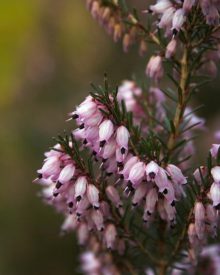 Heather is used for magick involving maturity, consummation, general luck, love, ritual power, conjuring ghosts, healing, protection, rain-making and water magick. Charms made with Heather can be worn or carried as protection against danger, rape and other violent crimes.
Heather is used for magick involving maturity, consummation, general luck, love, ritual power, conjuring ghosts, healing, protection, rain-making and water magick. Charms made with Heather can be worn or carried as protection against danger, rape and other violent crimes.
This flower represents good fortune and Heather can also be carried as a lucky charm. It was believed that wearing the blossom associated with your month of birth would bring exceptionally good luck – therefore people born in the month of Heather (August) should carry White Heather, for even better luck throughout the year.
Legend has it that a gift of white Heather brings luck to both the giver and the receiver, whereas red Heather is said to have been colored by heathens killed in battle by Christians, so is less lucky.
Heather is associated with secrets from the Otherworld. A sprig of white Heather placed in a special place of silence and meditation has the power to conjure ghosts, haints or spirits.
After picking a piece of white Heather at midnight, place it in a glass of river water in the darkest corner of your home. Sit and think of a departed loved one and it is said that the loved ones shadow will visit you.
Heather is said to ignite faery passions and open portals between their world and our own. Heather represents solitude because it thrives in wide open spaces, and Faeries who enjoy living in such undisturbed places are said to feast on the tender stalks of Heather. The Fae of this flower are drawn to humans who are shy.
Heather is useful for Solitary healing work (going within). Heather, if used along with Mistletoe, creates powerful healing medicine in both spiritual and physical aspects.
Heather can be used at Midsummer to promote love – carry red Heather for passion or white Heather for cooling the passion of unwanted suitors. If you give someone a gift of Heather it means: ‘Admiration’. A charm bag filled with Heather can be carried for decreasing egotism or self-involvement.
As a water herb, Heather is very useful in weather magick. When burned outdoors with Fern, the herbal smoke of Heather attracts rain. Bouquets of Heather and Fern can also be dipped in water to call rain.
Recommended Reading:
- Year of Moons, Season of Trees
- Tree Medicine Tree Magic
- A Druid’s Herbal
- Celtic Astrology
- Glamoury: Magic of the Celtic Green World
- The Book of Druidry
Source: dutchie.org
- Bluebells:
To attract faeries to dance in your garden. On Beltane eve, make an ankle bracelet of “Bluebells” and “jingle” bells to attract helpful fae folk to you.
- Clover:
A sacred faery plant, clovers of all kinds will attract them. Lay seven grains of wheat on a four-leafed clover to see the Faery.
- Elderberry:
Used to make Faery wine, these berries can be burned on a fire to invite the Good Folk to a gathering. Make a homemade brew of Elderberry Wine and you are sure to have some thirsty visitors. It is said that if a human drinks the wine, he or she will be able to see the Faery. If a human should drink Elderberry wine from the same goblet as a Faery being, he will be able to see them forever after.
- Elecampagne:
Also known as Elfswort. This root can be scattered around the home to attract the Sidhe. It can be added to any magick or spell to invoke Faery blessing.
- Foxglove:
The source of the modern heart drug Digitalis, Foxglove can have seriously dangerous results if taken internally. DO NOT INGEST!! Instead, plant Foxglove near your front door to invite the Faery in. Put a dried sprig of Foxglove in a talisman to keep you surrounded in Faery light.
- Heather:
Heather is said to ignite faery passions and open portals between their world and our own. Make an offering of Heather on “Beltane” eve to attract good fae to your garden
- Lilac:
The sweet scent is said to draw Fae spirits to your garden. Lilac and primroses for midsummers eve, will please the Fae.
- Mistletoe:
The most sacred herb of the Druids. Mistletoe is a magickal activator. In Faery spells, use a dash of Mistletoe taken on Summer Solstice to empower your workings with Faery magick.
- Milkweed:
Both Monarch butterflies and fairies like milkweed. If Milkweed is planted in a Witch’s garden, the fey will always be in the area. The silky tassels of the milkweed pods can be added to a dream pillow to not only make it softer, but also to make you dream of fairies. In the Autumn when the pods are bursting and the fluffy seeds are flying across the fields, a wish is granted for each seed that can be caught and then released again.
- Peony:
Peony seeds were once used to protect children from faeries. A garland of the seeds were placed around the child’s neck to keep them safe.
- Poppies:
Said to invoke the faery into your dreams Make a dream pillow of fresh poppies to entice the fae to your dreams.
- Primrose:
When planted in a garden or hung dried on the front door, primroses will attract the company of Faeries. If you have them growing under your care, do not let them die! The Faery will be deeply offended by your carelessness. Primroses are great in container gardens. Tie a pink ribbon around your container of Primroses while chanting; “Sacred roses, hear my cry for your protection, this I tie.”
- Roses:
Roses are loved by the fey so you can plant Roses in your garden to attract fairies. Their sweet scent will lure elemental spirits to take up residence close by. Roses can be used in Faery love spells. When performing the spell, sprinkle rose petals under your feet and dance softly upon them while asking the Faery for their blessing on your magick. Wild Roses are best for this purpose. Say the following spell as you plant your baby Rose bush:
“I ask a fairy from the wild,
To come and tend this wee rose-child.
A babe of air she thrives today,
Root her soul in the Goddesses’ good clay.
Fairies make this twig your bower,
By your magic shall time see her flower!”
- Thyme:
Wearing thyme will increase your ability to see the Sidhe. Sprinkle it at the base of your door, and on window sills to invite the Faery to enter your home.
~collected from a 17th century work
- Ruler: Venus
- Gender: Feminine
- Element: Water
- Type: Flower
- Magickal Form: Petals and flowers
- Deities: Freya, Ostara, Aphrodite, Artemis
- Basic Power: Friendship, Courtship, Divination
The Daisy is traditionally assigned to the month of April. A flower of friendship and courtship, the daisy is used to open up social or romantic opportunity. Add the petals to bathwater on Wednesdays to draw new friends. Place whole flowers on a love altar with pink candles to attract romantic possibilities.
Modern practices include the growing of Daisies as an herb to further attract the Devas and the Fae. Grieve’s “A Modern Herbal” suggests there may be an association between Daisies and a Dryad (a woodland nymph) named Belidis. Dryads are often associated with elemental Earth, and Daisies may be used ritually to help one commune with this element.
Decorate your altar or home with Daisies for Midsummer’s Eve. There is also a Magickal association with babies and newborn infants. The Daisy may be incorporated into baby blessings, or used to bring protective Magick into the baby’s sleeping area.
In Scotland because children use it to make daisy chains; daisy is an appropriate herb to decorate the cradle and the altar. The daisy brings love when worn. Sleeping with the root beneath your pillow may cause an absent love to return.
Decorate the house with daisies at Midsummer’s Eve to bring happiness to the home and to obtain the blessings of faeries. Daisies are also worn at Midsummer for luck and blessings. In the old times, young maidens would weave and wear daisy chains in their hair to attract their beloved.
Dreaming of Daisies is considered good luck in Spring, and bad luck in Winter. It is lucky to step on the first flowers in the spring but extremely unlucky to uproot them. Daisies were popular in Medieval times, when knights at tournaments wore the flower, while their ladies wore Daisy wreaths as crowns.
The daisy is the emotional and intellectual “getting to know you” flower. It is not a flower of passion and it is a great choice for young men and women who prefer a long courtship based on friendship and common goals.
Daisy divinations:
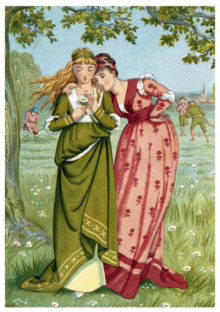 Daisy flowers are perhaps the best known of all plant divinations for love. One of the most touching literary allusions to the daisy divination is found in the garden scene in the first part of Goethe’s famous drama, Faust. In Germany, the daisy was known as:
Daisy flowers are perhaps the best known of all plant divinations for love. One of the most touching literary allusions to the daisy divination is found in the garden scene in the first part of Goethe’s famous drama, Faust. In Germany, the daisy was known as:
- Orakelblume – Oracle Flower
- Liebesblume – Love Flower
- Massliebchen – Little Measure of Love
Divination with daisies most commonly consists of removing each petal from the daisy while saying “she loves me, she loves me not.” (The masculine pronoun is used where appropriate.) The sentence stated as the last petal removed reveals the truth. Any daisy-like flower can be used.
This technique can be further improved upon by placing daisy roots under your beneath your pillow to dream of your true love.
A second form of daisy divination isn’t limited to matters of love. Ask a binary question. As you pluck each petal, say yes or no. As the last petal falls, the answer has been given.
A very short poem from the 1800’s gives us this variation:
- He loves me
- He don’t
- He’ll have me
- He won’t
- He would if he could
- But he can’t
- So he won’t
Another form of daisy divination is as follows:
Get a bunch of daisies and put them on a table. With eyes closed, take a handful while asking how many days you will wait to be asked for a date. If you prefer, you may ask in weeks or months. Open your eyes and count the picked daisies. The number of flowers represents the number of days you will wait. This can also be used to count the time till you will marry.
This can also be done while sitting on a daisy-laden lawn, closing your eyes and grabbing a handful of grass. The number of daisies you end up with in your hand will determine the number of months until you marry. If you do not have access to a daisy filled yard, dandelions make for an acceptable substitute.
Collected from various sources
When the Moon is at the full,
mushrooms you can safely pull,
but when the Moon is on the wane,
wait ere you think to pluck again.
Along with oysters, mushrooms have always been considered aphrodisiacs. The aphrodisiacal effect was increased if the mushrooms were picked at the time of the full moon.
Primitive people treated mushrooms with great respect, as it was so difficult to determine whether they were safe to eat. Even experts on mushrooms need to remember the old saying, “There are old mushroom hunters and bold mushroom hunters, but there are no old, bold mushroom hunters.”
Many mushrooms have “magical” properties, the toxins within them seeming to provide a gateway to another world. Images of fairies, elves, and goblins inevitably have a mushroom or toadstool nearby. In Chinese Mythology, mushrooms were one of the sacred foods eaten by the Immortals; they induced bodily lightness. Further, the fly agaric mushroom was said to grow only during times of peace and prudent leadership.
- Ruler: Neptune
- Type: Vegetable
- Magickal Form: Raw, cooked
This is the “flower” of illusion and many mushrooms are actually hallucinogenic. All mushrooms hold the property of fantasy and are eaten to invoke glamour or to create illusions.
- For love they should be cooked in soups with paprika and/or fish.
- To create glamours, or illusions, eat them raw.
The hallucinogenic effect of fungi has always been known, and used by shamans and warriors preparing for battle. Native Americans used hallucinogenic mushrooms in rites to produce visions, or embark on vision quests.
Rock paintings dating back at least 2000 years ago in the Tassili Plateau in southern Algeria depict shamans, apparently dancing around, holding mushrooms in their hands, with mushrooms sprouting from their bodies.
The Hebrews considered mushrooms as sacred and only priests were allowed to eat them.
Mushrooms were considered a delicacy in Roman times, but there was always the problem of determining whether or not they were edible. Emperor Claudius had this problem solved, as he used a food taster to eat some of his food first. Unfortunately, the mushrooms his taster tried one night produced no immediate effects. Consequently, Emperor Claudius ate them, and both he and his taster died. It is widely believed that his second wife, Aggripinna, who wanted her son Nero to have the throne, deliberately poisoned her husband.
Collected from various sources
